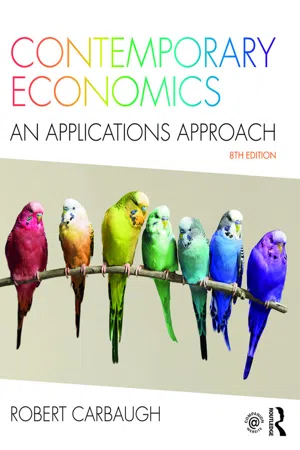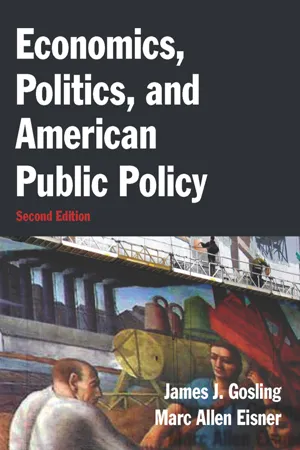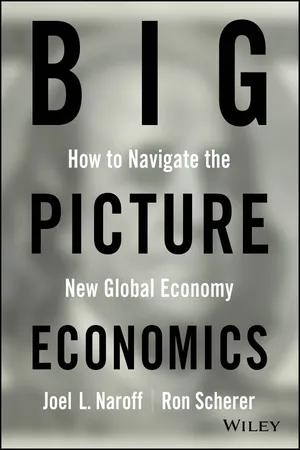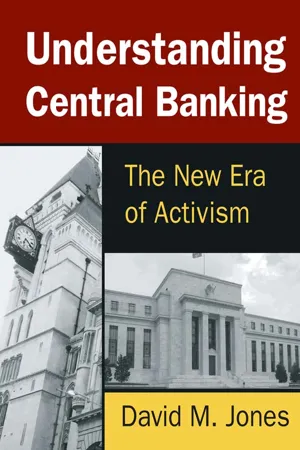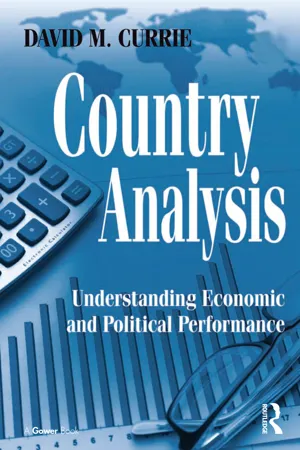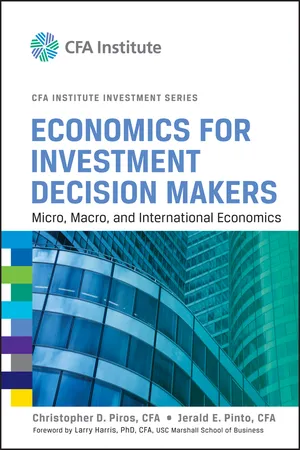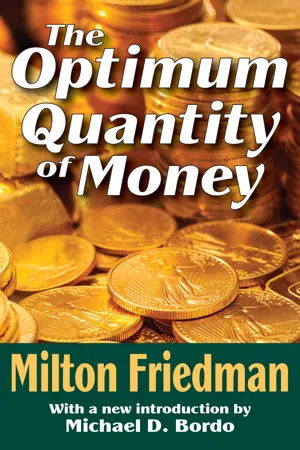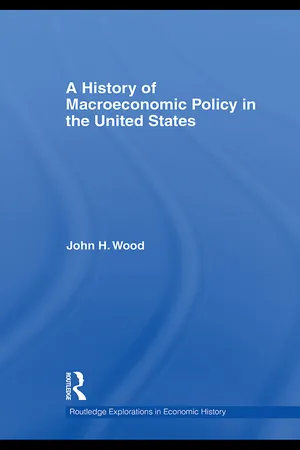Economics
FED Monetary Policy
The Federal Reserve's (FED) monetary policy refers to the central bank's actions to manage the money supply and interest rates to achieve economic goals such as price stability, full employment, and sustainable economic growth. It involves tools like open market operations, discount rates, and reserve requirements to influence borrowing, spending, and investment in the economy.
Written by Perlego with AI-assistance
Related key terms
10 Key excerpts on "FED Monetary Policy"
- No longer available |Learn more
Contemporary Economics
An Applications Approach
- Robert Carbaugh(Author)
- 2016(Publication Date)
- Routledge(Publisher)
- The Federal Reserve System, often simply called the Fed, is the central bank of the United States. It was legislated by Congress and signed into law by President Woodrow Wilson in 1913 to provide the nation with a safer, more flexible, and more stable monetary and financial system.
- The Fed’s structure was designed by Congress to give it a broad perspective on the economy. At the head of the Fed’s formal organization is the Board of Governors. The 12 regional Federal Reserve Banks make up the next level. The organization of the Fed also includes the Federal Open Market Committee and three advisory councils. The Federal Reserve’s stockholders are commercial banks that are members of the Fed.
- The Fed, as the overseer of the nation’s monetary system, has many important duties: acting as the lender of last resort, regulating and supervising banks, supplying services to banks and to the government, conducting foreign exchange operations, and controlling the money supply and interest rates.
- The Fed’s main responsibility is to formulate and implement monetary policy, which is conducted by changing the economy’s money supply in order to help the economy achieve maximum output and employment, as well as stable prices. The Fed uses three policy instruments to influence the money supply: open market operations, the discount rate, and the reserve requirement.
- In the short run, when prices are temporarily fixed, the Fed has the ability to affect the level of interest rates in the economy. When the Fed increases the money supply to reduce interest rates, aggregate demand increases, which results in an increase in output and employment. Conversely, a decrease in the money supply will reduce aggregate demand, output, and employment. In the long run, a change in the money supply by the Fed affects only prices and not the level of output and employment.
- One strength of monetary policy is that it is highly impersonal: Monetary policy interferes very little with the freedom of the market. Monetary policy is also flexible and can be implemented quickly in response to changing economic circumstances. Finally, the Fed is insulated from day-to-day political pressures, so it can act in the best interests of the economy. This allows the Fed to engage in policies that might be unpopular but necessary for the long-run health of the economy.
- eBook - ePub
- James Gosling, Marc Allen Eisner(Authors)
- 2015(Publication Date)
- Routledge(Publisher)
Unlike fiscal policy, for which Congress directly exercises its constitutional power to tax and spend, Congress has vested the authority for monetary policy in an independent government agency, the Federal Reserve. The Federal Reserve sets national monetary policy by influencing the availability and cost of credit in the United States, as it affects the level of reserves that financial institutions have available to lend to willing borrowers and the interest rates charged.Monetary policy can be employed to stimulate the economy. By increasing the supply of money, interest rates can be reduced, which creates incentives for corporations to make major capital purchases. Moreover, if loanable funds become available at an attractive rate, and if would-be consumers believe that interest rates are more likely to go up rather than down later, that perceived lower cost of money might just be enough to get them to borrow and make the investment. Monetary policy can also be an effective tool in an overheated economy. The objective in that condition is to lower aggregate demand, trading off reduced inflation for some increase in unemployment. Monetary policymakers act to tighten the availability of credit and increase its costs. A steep increase in the cost of loanable funds creates a disincentive for credit-financed spending. Consumers and businesses tend to wait for more favorable interest rates. If enough people behave that way, aggregate demand declines, unemployment rises, and inflation drops.It is far more difficult to control long-term interest rates, which are set in a highly competitive market in which borrowers bid for capital. But, as noted, monetary policy can influence short-term rates. Not only does the short-term cost of loanable funds affect the relative willingness of borrowers to take on debt, short-term interest rates send important signals about what the future economy might portend. Investors who believe that a modest increase in short-term interest rates presages a series of future increases are less likely to purchase long-term securities than are those who see a solitary adjustment acting to nip inflationary tendencies in the bud. Thus, interest rate changes, the way they are positioned by monetary policymakers, and the perspectives of would-be investors can all influence the behavior of participants in capital markets. - eBook - ePub
Big Picture Economics
How to Navigate the New Global Economy
- Joel Naroff, Ron Scherer(Authors)
- 2014(Publication Date)
- Wiley(Publisher)
Chapter 9 Monetary Policy: Money, or Maybe the Federal Reserve, Makes the World Go ’RoundThe Fed is assumed to be all-knowing and all-powerful: wrong and wrong. How monetary policy works is discussed in this chapter, but much more important, how the same policy can be successful or a failure depending on the type of policy and the context in which it is implemented.In the past two chapters, we saw how difficult it is to create fiscal policy even if the government wasn’t as dysfunctional as it is. Whether it is raising taxes or lowering them, how that is done, and the economic implications are frequently unknown even to those making the decisions. Worse, the differential effects of alternative policies may not even be a factor in many fiscal policy decisions since politics rather than economics usually drives taxation decisions.When it comes to the expenditure side of the budget, be it cutting spending, funding massive stimulus projects, or implementing mindless sequestration, the government rarely has any idea what it is doing. There are even politicians who think it is possible to balance the budget. In other words, fiscal policy is more a matter of political dogma and expediency than any logical or rational approach to economic growth.In the face of all that chaos, the members of the Federal Reserve have to determine what is the best course for monetary policy. Is this a job that even Superman would hesitate to take on? Probably. But someone has to do it, and it does get done—often better than anyone could imagine.How Monetary Policy Works
The Federal Reserve came into being in 1914 largely because people basically didn’t trust banks. And they had very good reason to worry. No, it wasn’t just because Butch Cassidy and the Sundance Kid were riding around robbing banks and trains. Essentially, banks operate in a perpetual state of bankruptcy. They take in money and usually lend out more than they have on hand. That creates a small problem called liquidity - eBook - ePub
Understanding Central Banking
The New Era of Activism
- David Jones(Author)
- 2014(Publication Date)
- Routledge(Publisher)
On October 8, 2008, in recognition of the fact that the post–Lehman Brothers bankruptcy had intensified the financial crisis and further stifled the possibility of growth, the Fed joined five other central banks (the European Central Bank, the Bank of England, the Bank of Canada, the Swiss National Bank, and the Swedish National Bank) in cutting their official rates by 50 basis points (a half percentage point). The Fed cut its federal funds rate target to 1.5 percent from 2.0 percent and its discount rate to 1.75 percent from 2.25 percent. This coordinated rate cut set a record for the number of central banks involved in such a high visibility monetary policy action. At their regularly scheduled FOMC meeting in late October 2008, the monetary authorities lowered their federal funds rate target and discount rate by an additional 50 basis points to 1 percent and 1.25 percent, respectively. Although Fed officials hinted that there would likely be no further policy rate cuts, they did not completely rule out this option, noting that “downside risks to growth remain.”OBJECTIVES OF MONETARY POLICYAs mentioned earlier, the Fed has a dual mandate from Congress regarding monetary policy objectives: maintaining price stability and maximum employment (sustainable economic growth). According to the Federal Reserve Act, as amended in 1978, “The Board of Governors of the Federal Reserve and the Federal Open Market Committee shall maintain long run growth of the monetary and credit aggregates commensurate with the economy’s long run potential to increase production, so as to promote effectively the goals of maximum employment, stable prices, and moderate long-term interest rates.” Since long-term interest rates will be very high only if there is high inflation, the Fed is left with a difficult balancing act.The Fed’s dual mandate from Congress grew out of the Employment Act of 1946, which designated the responsibility for economic stability to the federal government. The act specifically encouraged the federal government to pursue “maximum employment, production, and purchasing power” and established both the President’s Council of Economic Advisers and the Congressional Joint Economic Committee, the former to be largely responsible for microeconomic policies and the latter to oversee macroeconomic policies. The Humphrey-Hawkins Full Employment and Balanced Growth Act of 1978 assigned responsibility for the objectives of price stability and maximum employment to the Federal Reserve, presumably supported by the automatic stabilization features of fiscal policy (namely, automatic budget deficits to counter recessions and budget surpluses to contain expansions). Humphrey-Hawkins also instructed the Federal Reserve Board to transmit monetary policy reports to Congress twice a year. - eBook - ePub
- Todd A. Knoop(Author)
- 2019(Publication Date)
- Greenwood(Publisher)
In 1980, two-thirds of countries had inflation rates of greater than 10 percent, one-third of countries were experiencing negative output growth, and financial crises were more common. Today, only one out of six countries has an inflation rate greater than 10 percent, and economic growth has never been as broadly enjoyed as now. There has never been a better time to be a median person on this globe than right now (2019). There are many factors that have contributed to these improvements, but one of them is better central banking. Across the globe, governments have learned that central banks work best when they are independent of direct political pressure but held politically accountable to the public through being transparent in their actions. More independent central banks that are run by trained professionals have been able to give their respective economies the best of all worlds: greater financial stability, lower inflation, and faster economic growth. In many ways, it has been the U.S. Fed that has set the gold standard for how modern central banks are supposed to behave and provided a model for most central banks across the world.HOW THE FEDERAL RESERVE SETS MONETARY POLICY AND INFLUENCES INTEREST RATESCentral banks play a crucial role in determining the size of the money supply. Central banks have the power to change the money supply in two ways. First, they can change the amount of currency in circulation by printing more money—that is simple enough. The other way that a central bank can change the money supply is by changing the total reserves held by banks. Total reserves are the money deposits that banks hold at the Fed on account. Central banks can change the level of total reserves held by banks by creating more reserves for banks to hold. When a central bank increases the level of total reserves in the banking system, then banks have more liquidity and they are able to extend more loans. Some of these loans will be held in checkable deposits that allow banks to create even more loans, generating an expansion in checkable deposits. This deposit expansion process increases the money supply, because the money supply (M1) is both currency and checkable deposits.To say this more simply, a central bank can create liquidity by printing more currency or increasing the amount of liquid reserves that banks have to make loans. When a central bank does either of these things, it increases not just the level of currency but also the level of checkable deposits, increasing the money supply.While central banks can increase or decrease the money supply, central banks do not have complete control over how large these changes in the money supply will be. Central banks only have complete discretion in setting one component of the money supply—the level of currency—and can influence the level of checkable deposits by changing the level of bank reserves. One way to think about how central banks influence the money supply is with the following analogy: Think about the money supply as a poorly trained dog out on a walk, the dog’s leash as the tools that the central bank controls (the level of currency and bank reserves), and the central bank as the person who is holding the leash. As the money supply begins to veer off route, the central bank has the power to yank the money supply back on course. However, the dog’s path will not proceed in a straight line, and if the leash is long or the dog is strong, the path might be quite unpredictable at times. Likewise, a central bank’s control over the money supply is good over the long term, but over the short term, it can be quite loose. - eBook - ePub
Country Analysis
Understanding Economic and Political Performance
- David M. Currie(Author)
- 2016(Publication Date)
- Routledge(Publisher)
The tools are used with different frequency, as you’ll notice when you’re aware of them over a period of time. The Fed buys and sells securities daily or weekly, for example, while the reserve requirement changes perhaps once in a decade under ordinary circumstances. The tools also have different degrees of effectiveness. For example, changing the reserve requirement only slightly leads to dramatic changes in bank lending and consequently in the performance of the economy. All these tools have the effect of influencing credit conditions by raising or lowering interest rates throughout the economy. Credit conditions are the ability or tendency to lend or borrow, a practice we have turned into a national obsession in the US. The same tools are available in other countries, although they frequently have different names.The three tools can be used to implement monetary policy, the desire of the central bank to influence economic conditions such as unemployment, inflation, or the foreign exchange value of the nation’s currency. When people don’t have jobs or businesses are not selling as much as they wish, the central bank may pursue an easy money policy by making more money available through the banking system. When the rate of inflation is high, the central bank may pursue a tight money policy by making money more difficult to obtain. Using the three tools to influence the right amount of money in an economy is a delicate task. This is the central bankers’ dilemma : striking the balance between too much money, which causes inflation, and too little money, which causes recession. Box 6.3 describes how three central banks viewed the dilemma in mid-2007. Box 6.4 explains the dilemma facing the Fed shortly after a new chairman was appointed.Box 6.3 Different economic conditions, different bank policiesCentral bank policies depend on economic and financial conditions in the home country. This became evident about the time of the Northern Rock crisis described in Box 6.2 - eBook - ePub
Economics for Investment Decision Makers
Micro, Macro, and International Economics
- Christopher D. Piros, Jerald E. Pinto(Authors)
- 2013(Publication Date)
- Wiley(Publisher)
But the most important interest rate used in U.S. monetary policy is the federal funds rate. The federal funds rate (or fed funds rate) is the interbank lending rate on overnight borrowings of reserves. The Federal Open Market Committee (FOMC) seeks to move this rate to a target level by reducing or adding reserves to the banking system by means of open market operations. The level of the rate is reviewed by the FOMC at its meetings held every six weeks (although the target can be changed between meetings, if necessary). Through the setting of a policy rate, a central bank can manipulate the amount of money in the money markets. Generally speaking, the higher the policy rate, the higher the potential penalty that banks will have to pay to the central bank if they run short of liquidity, the greater will be their willingness to reduce lending, and the more likely it will be that broad money growth will shrink. 2.3.2.3. Reserve Requirements The third primary way in which central banks can limit or increase the supply of money in an economy is via their reserve requirements. We have already seen that the money creation process is more powerful the lower the percentage reserve requirement of banks. So, a central bank could restrict money creation by raising the reserve requirements of banks. However, this policy tool is not used much nowadays in developed economies. Indeed, some central banks, such as the Bank of England, do not even set minimum reserve requirements for the banks under their jurisdiction anymore. Changing reserve requirements frequently is disruptive for banks. For example, if a central bank increased the reserve requirements, a bank that was short on reserves might have to cease its lending activities until it had built up the necessary reserves, because deposits would be unlikely to rise quickly enough for the bank to build its reserves in this way - Maureen Burton, Reynold F. Nesiba, Bruce Brown(Authors)
- 2015(Publication Date)
- Routledge(Publisher)
policy directive to the Trading Desk of the New York Fed that guides the conduct of open market operations until the next FOMC meeting approximately six weeks later. The directive, which is accompanied by a statement, is the link between the decisions formulating policy and the actions implementing policy. The policy directive and accompanying statement for the March 18, 2008, meeting of the FOMC is reproduced here.Policy Directive
A statement issued by the FOMC to the Trading Desk of the New York Fed that directs monetary policy until the next FOMC meeting; in recent years, the policy directive has targeted a specific fed funds rate.“The Federal Open Market Committee seeks monetary and financial conditions that will foster price stability and promote sustainable growth in output. To further its long-run objectives, the Committee in the immediate future seeks conditions in reserve markets consistent with reducing the federal funds rate to an average of around 2 ¼ percent.”The vote encompassed approval of the following statement:The Federal Open Market Committee decided today to lower its target for the federal funds rate 75 basis points to 2 ¼ percent.Recent information indicates that the outlook for economic activity has weakened further. Growth in consumer spending has slowed and labor markets have softened. Financial markets remain under considerable stress, and the tightening of credit conditions and the deepening of the housing contraction are likely to weigh on economic growth over the next few quarters.Inflation has been elevated, and some indicators of inflation expectations have risen. The Committee expects inflation to moderate in coming quarters, reflecting a projected leveling-out of energy and other commodity prices and an easing of pressures on resource utilization. Still, uncertainty about the inflation outlook has increased. It will be necessary to continue to monitor inflation developments carefully.Today’s policy action, combined with those taken earlier, including measures to foster market liquidity, should help to promote moderate growth over time and to mitigate the risks to economic activity. However, downside risks to growth remain. The Committee will act in a timely manner as needed to promote sustainable economic growth and price stability.- eBook - ePub
- Milton Friedman(Author)
- 2017(Publication Date)
- Routledge(Publisher)
5The Role of Monetary PolicyTHERE IS WIDE AGREEMENT about the major goals of economic policy: high employment, stable prices, and rapid growth. There is less agreement that these goals are mutually compatible or, among those who regard them as incompatible, about the terms at which they can and should be substituted for one another. There is least agreement about the role that various instruments of policy can and should play in achieving the several goals.My topic for tonight is the role of one such instrument—monetary policy. What can it contribute? And how should it be conducted to contribute the most? Opinion on these questions has fluctuated widely. In the first flush of enthusiasm about the newly created Federal Reserve System, many observers attributed the relative stability of the 1920s to the System’s capacity for fine tuning—to apply an apt modern term. It came to be widely believed that a new era had arrived in which business cycles had been rendered obsolete by advances in monetary technology. This opinion was shared by economist and layman alike, though, of course, there were some dissonant voices. The Great Contraction destroyed this naive attitude. Opinion swung to the other extreme. Monetary policy was a string. You could pull on it to stop inflation but you could not push on it to halt recession. You could lead a horse to water but you could not make him drink. Such theory by aphorism was soon replaced by Keynes’ rigorous and sophisticated analysis.Keynes offered simultaneously an explanation for the presumed impotence of monetary policy to stem the depression, a nonmonetary interpretation of the depression, and an alternative to monetary policy for meeting the depression. His offering was avidly accepted. If liquidity preference is absolute or nearly so —as Keynes believed likely in times of heavy unemployment—interest rates cannot be lowered by monetary measures. If investment and consumption are little affected by interest rates—as Hansen and many of Keynes’ other American disciples came to believe—lower interest rates, even if they could be achieved, would do little good. Monetary policy was twice damned. The contraction, set in train on this view by a collapse of investment or by a shortage of investment opportunities or by stubborn thriftiness, could not, it was argued, have been stopped by monetary measures. But there was available an alternative—fiscal policy. Government spending could make up for insufficient private investment. Tax reductions could undermine stubborn thriftiness. - John H. Wood(Author)
- 2009(Publication Date)
- Routledge(Publisher)
knowledge of the policy process is woefully inadequate,… dominated by extremely short-run week-to-week, day-to-day, or hour-to-hour events in the money and credit markets. [T]heir viewpoint is frequently that of a banker rather than that of a regulating authority for the monetary system and the economy.Friedman observed that the Fed ‘naturally interpreted’ the world in terms of its immediate environment (US Congress 1964: 927, 1163). Keynesian populizer Alvin Hansen (1955) thought the Fed’s fear of upsetting the market ‘one of the most curious arguments I have ever encountered’, and Sidney Weintraub (1955) suggested that the Fed should be interested less in financial stability and more with ‘broader conceptions of economic policy’.Many of these criticisms were on the mark, particularly those directed at the Fed’s focus on the financial markets. However, they overlooked its attention to expectations even though the two were inseparable. Stable price expectations have always been thought by the monetary authorities, and usually by economists (the Keynesian era excepted), to be indispensable to financial and general economic stability. The discussion in the next section shows that, contrary to Green, Woodford, and Clarida et al., monetary policymakers’ understanding of the economy, with its emphasis on credibility and the role of expectations in generating price fluctuations, has been stable since the founding of the Fed, and indeed long before then. Economists have followed the Fed in recent years rather than the other way around. Another difference between the knowledge of economists and monetary policymakers is the greater stability of the latter—consistent with the opening epigraph from Hume and fiscal policy as shown in Chapter 4 . Economists gyrated from classical to Keynesian to New Classical theories while the Fed continues to see the world today much as it did in the 1920s.The vital roles of the price level and its expectations in the Fed’s model of monetary policy are described in the following section. The Fed’s actions are governed by its interests subject to its knowledge. Conveniently for the Fed, both point to financial stability, which includes price stability because credit is governed by expectations. Booms and busts are bad for everyone, including banks, in whose interests the Fed was founded, and has continued to be their main political support. Only the bankers defended the Fed to Patman (US Congress 1964: 1231, 1876, 1882).
Index pages curate the most relevant extracts from our library of academic textbooks. They’ve been created using an in-house natural language model (NLM), each adding context and meaning to key research topics.
